|
Star Music Hall / Peoples' Palace / Palace Theatre Concert Hall Court (St John's Court), Manchester Road, Bradford.
Quick links to other sections on this page . . .
Location William Morgan In 1875 he had the vision of a Music Hall and a Theatre as a double-stacked construction (ie. two halls - one on top of the other) making maximum usage of the sloping ground and separate means of ingress and egress. It was believed to be the only theatre construction of its kind in the country. The design for the two theatres was entrusted to Jackson & Longley (Samuel Jackson of Kirkgate and William Longley of Bermondsey, Bradford.) where basically the lower part was to be a two-deck music hall and the upper part a three-deck theatre with their respective stages and auditoria directly in line above one another and facing in the same eastwards direction. The Building The entrance was two arched doors each 15feet wide and 15ft 6ins high, one leading to the pit and the other to the gallery - there was no dress circle in the music hall. Other smaller arched doors at 11feet wide were the stage door and exit door from the pit. The total height of the building at point was 78feet from St John's Court level. Interior The steep stepped gallery with 6 rows of 400 seats plus 600 standing giving 2,100 in total. There were six private boxes, three at each side and the walls either side of the stage splayed to allow better viewing from the side gallery end seats. Both pit and gallery each had a refreshment room/bar at the rear of their promenades. The raked stage was 6ft above the floor of the pit with a proscenium opening 26ft wide and 21ft high with a wall-to-wall width of 50ft and 19ft deep to back and without any fly facilities. There were five dressing rooms and the whole theatre lit by gas. The auditorium was lit by 12 sunlights - three at each side of the gallery and the same in the pit; the hot air carried off by sheet iron flues. The gallery and flat ceiling were supported by many substantial cast iron pillars and above the 35ft high ceiling were girders and thick concrete to form the floor of the theatre to be built above in the continuing second phase of construction. There would be no transfer of sound from one hall to the other. Conditional Opening Star Music Hall opened on Monday 23rd August 1875 with . . . Amy Ellis, H.F Juleene, Fritz TroupeA complaint from the opening night was of the poor ventilation which Morgan promised to address. Indeed ventilation shafts were included in the design and being built in conjunction with the Prince's Theatre above whose construction work continued during the daytime. Fire Disaster Above Lesee: Mr A Kershaw. Cinématographe Peoples' Palace, BradfordIt is believed that the Cinématographe apparatus was operated by Matt Raymond (1874-1941), the Lanternist from the London Polytechnic Institute who had been trained by the Lumière Brothers. This special week-long attraction was reported in the Bradford Observer . . . "The visit of the Cinématographe to Bradford (Peoples' Palace) will give the curious an opportunity of becoming acquainted with one of the most remarkable and suggestive of all scientific toys that have been provided for a generation which has almost ceased to believe in any scientific impossibility.[ For the record: Edison's machine was previously show in Bradford's Kinetoscope Parlour installed in an art shop in Town Hall Square in 1895 - the moving images were seen peepshow fashion (not projected) rather like the later 'What the Butler Saw' type machines. ] The Bradford Daily Telegraph similarly enthused . . . "Enormous Attraction for the Easter Holidays at Andrew Roberton, a lessee of the Peoples' Palace along with his manager, R. Ernest Liston, arranged with Henry Hibbert to hire the hall on Sundays for his famous lanternslide lectures. Hibbert was noted for his connections with the Temperance Movement and the PSA (People's Sobriety Association) in Bradford. Hibbert was later to pioneer both films and cinemas and more can be found on Temperance Hall and Towers Hall cinema history webpages. Folly - or not? "It had a varied career and in 1881 its name was changed to the Folly, an appropriate name, for it had been a folly to change it, and it was soon back to the Star".In later years, another T & A theatre writer had a different view on the name 'Folly' but this time applied to the Prince's Theatre above - see Prince's history page for more details; so which version is correct? A later Lessee was the Pullan family where Henry Pullan had previously run their Pullan's Music Hall (1868-1889) in Brunswick Place (off Westgate) and he took control of both the Star Music Hall and the Prince's Theatre in 1887 when Charles Pullan was to succeed his father Henry Pullan. Vaudeville In 1911 MacNaghten opened the Hippodrome in a converted roller skating rink in Barkerend Road; this was for his new Kine-Variety venture and Mozley was to take over as general manager there. Variety The Palace continued its rôle as a variety theatre although some films from the 'war front' of the 1914-18 First World War were shown as part of the variety bill on the now commonplace Bioscope apparatus. Seating capacity was now a more comfortable 1,200. The Palace boasted that it was one of the first in England to be heated by electricity claiming "This is not only cleaner and safer but it has the advantage of being able to control the temperature of the theatre much quicker and easier from the switchboard than it would be from a hot water boiler". Closure However, closure was forced on the Palace by order of the Watch Committee for Saturday 28th May 1938 for alleged "structural defects" which were not clarified - an interesting reason as the Palace structure supported the Prince's Theatre above which remained in use for another 23 years. There is another story that the very 'straight-laced' Francis Laidler running the successful Prince's Theatre above (and his nearby Alhambra) had objected to "seedy nature" of the Palace promenade areas which had now gained a notorious reputation. Perhaps this might have influenced the refusal of a licence. 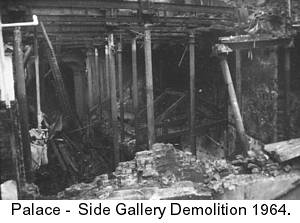
The Palace closed on Saturday 28th May 1938 with "Paulo - the singing clown and BBC Palace of Varieties sensation" as top of the bill. After auctioning off the fixtures and fittings, the building was then used for the storage of wool for the adjacent warehouses and also for storing scenery for the Prince's Theatre above. The former Star/Palace and Prince's Theatre were demolished in 1964 as part of the road widening scheme and the site is now part of the garden area in front of the National Media Museum. 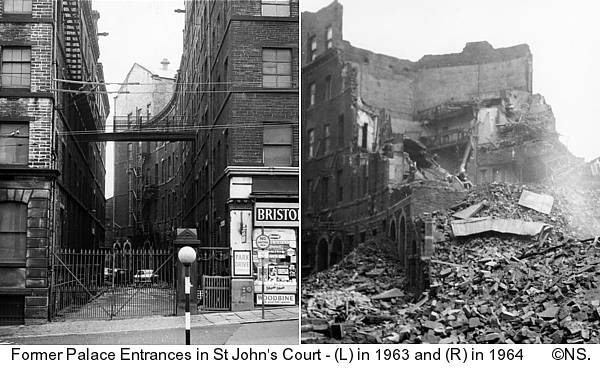 Location Myth This is not strictly correct. The actual site of the Palace was north (towards city) of the Museum where the gardens slope away by the J.B Priestley statue and extending eastwards across the corner of Pictureville Cinema into what is now Prince's Way - the new road created westwards of the original continuation of Manchester Road. Further Reading May not be copied or reproduced without permission.
|
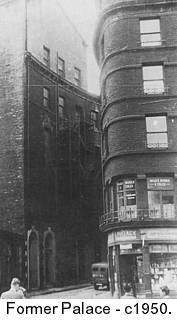
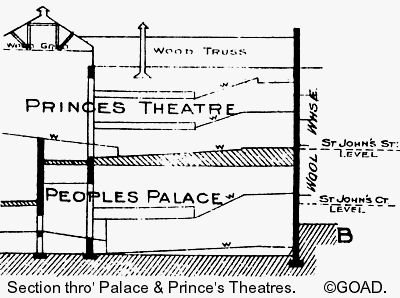 The site was of interest to William Morgan - a wholesale and retail bookseller, stationer and proprietor of newsrooms with premises at 31 Kirkgate. In 1872 Morgan promoted Saturday Night Entertainments at the
The site was of interest to William Morgan - a wholesale and retail bookseller, stationer and proprietor of newsrooms with premises at 31 Kirkgate. In 1872 Morgan promoted Saturday Night Entertainments at the 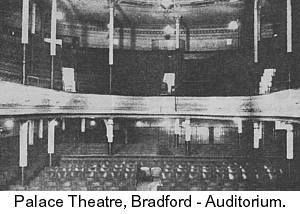 The pit (stalls) was below street level and accessed by 28 wide steps to the wooden paybox. The ascent to the gallery and promenade was easier as it was almost at ground level. The raked floor of the pit had a fall of 4ft 6ins back to front ensuring good sightlines with seating in two blocks with centre and side aisles accommodating 1,100 persons seated and standing at rear.
The pit (stalls) was below street level and accessed by 28 wide steps to the wooden paybox. The ascent to the gallery and promenade was easier as it was almost at ground level. The raked floor of the pit had a fall of 4ft 6ins back to front ensuring good sightlines with seating in two blocks with centre and side aisles accommodating 1,100 persons seated and standing at rear.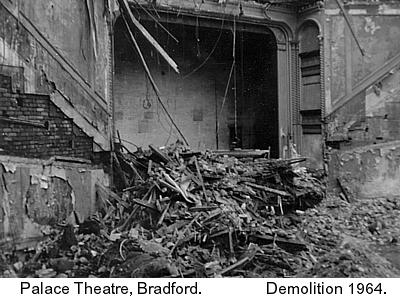 After a notable theatre history, the Palace found it difficult to complete with the more modern and popular
After a notable theatre history, the Palace found it difficult to complete with the more modern and popular  The National Media Museum has a plaque on the wall at the foot of the main staircase claiming "this was the site of the Palace Theatre" remembering that it was underneath the Prince's Theatre.
The National Media Museum has a plaque on the wall at the foot of the main staircase claiming "this was the site of the Palace Theatre" remembering that it was underneath the Prince's Theatre.